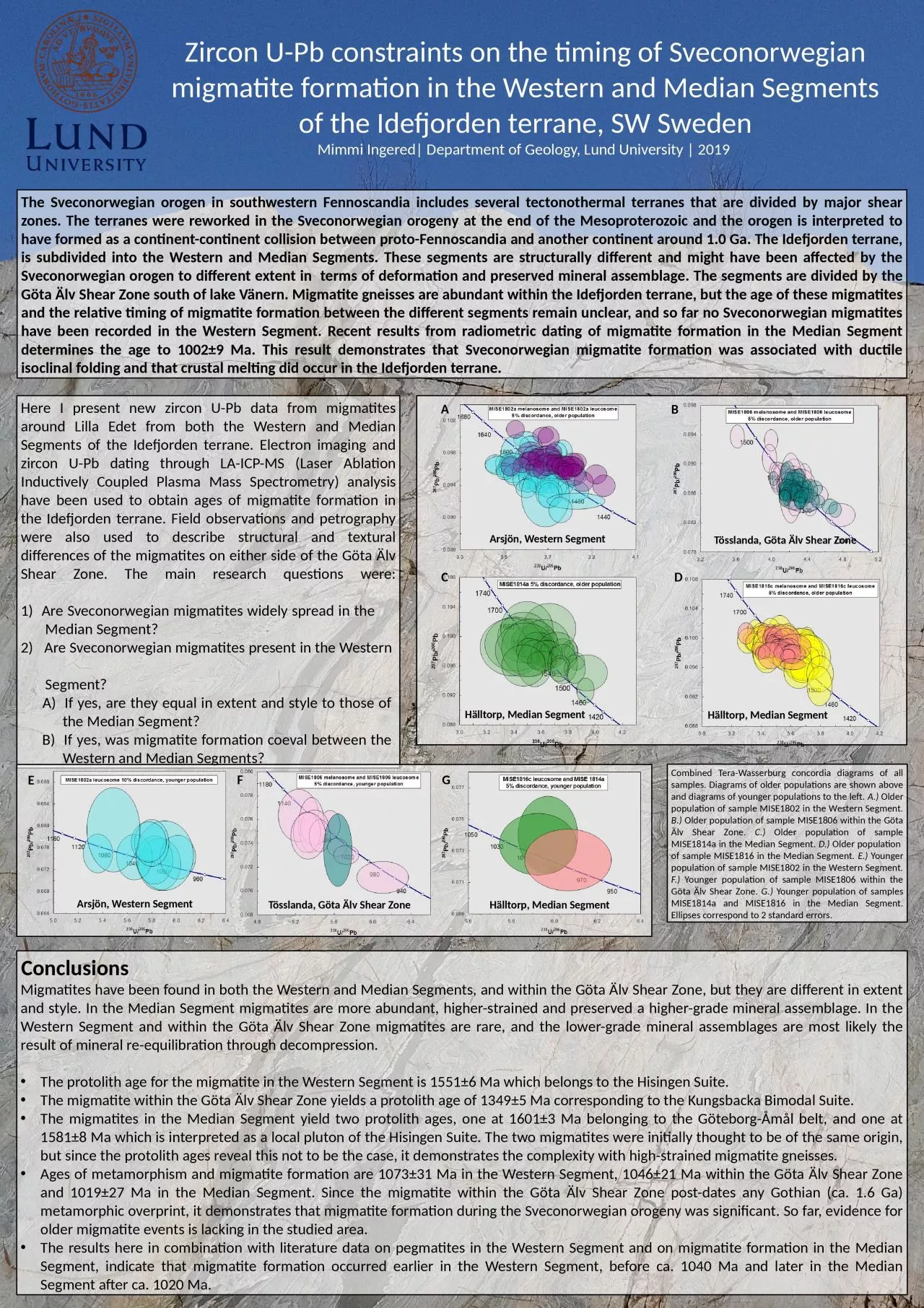

The protolith age for the migmatite in the Western Segment is 15516 Ma which belongs to the Hisingen Suite The migmatite within the Göta Älv Shear Zone yields a protolith age of 13495 Ma corresponding to the Kungsbacka Bimodal Suite ID: 930718
Download Presentation The PPT/PDF document "Migmatites have been found in both the ..." is the property of its rightful owner. Permission is granted to download and print the materials on this web site for personal, non-commercial use only, and to display it on your personal computer provided you do not modify the materials and that you retain all copyright notices contained in the materials. By downloading content from our website, you accept the terms of this agreement.
Slide1
Migmatites
have been found in both the Western and Median Segments, and within the Göta Älv Shear Zone, but they are different in extent and style. In the Median Segment migmatites are more abundant, higher-strained and preserved a higher-grade mineral assemblage. In the Western Segment and within the Göta Älv Shear Zone migmatites are rare, and the lower-grade mineral assemblages are most likely the result of mineral re-equilibration through decompression.The protolith age for the migmatite in the Western Segment is 1551±6 Ma which belongs to the Hisingen Suite.The migmatite within the Göta Älv Shear Zone yields a protolith age of 1349±5 Ma corresponding to the Kungsbacka Bimodal Suite. The migmatites in the Median Segment yield two protolith ages, one at 1601±3 Ma belonging to the Göteborg-Åmål belt, and one at 1581±8 Ma which is interpreted as a local pluton of the Hisingen Suite. The two migmatites were initially thought to be of the same origin, but since the protolith ages reveal this not to be the case, it demonstrates the complexity with high-strained migmatite gneisses.Ages of metamorphism and migmatite formation are 1073±31 Ma in the Western Segment, 1046±21 Ma within the Göta Älv Shear Zone and 1019±27 Ma in the Median Segment. Since the migmatite within the Göta Älv Shear Zone post-dates any Gothian (ca. 1.6 Ga) metamorphic overprint, it demonstrates that migmatite formation during the Sveconorwegian orogeny was significant. So far, evidence for older migmatite events is lacking in the studied area.The results here in combination with literature data on pegmatites in the Western Segment and on migmatite formation in the Median Segment, indicate that migmatite formation occurred earlier in the Western Segment, before ca. 1040 Ma and later in the Median Segment after ca. 1020 Ma.
Zircon U-Pb constraints on the timing of Sveconorwegian migmatite formation in the Western and Median Segments of the Idefjorden terrane, SW SwedenMimmi Ingered| Department of Geology, Lund University | 2019
The Sveconorwegian orogen in southwestern Fennoscandia includes several tectonothermal terranes that are divided by major shear zones. The terranes were reworked in the Sveconorwegian orogeny at the end of the Mesoproterozoic and the orogen is interpreted to have formed as a continent-continent collision between proto-Fennoscandia and another continent around 1.0 Ga. The Idefjorden terrane, is subdivided into the Western and Median Segments. These segments are structurally different and might have been affected by the Sveconorwegian orogen to different extent in terms of deformation and preserved mineral assemblage. The segments are divided by the Göta Älv Shear Zone south of lake Vänern. Migmatite gneisses are abundant within the Idefjorden terrane, but the age of these migmatites and the relative timing of migmatite formation between the different segments remain unclear, and so far no Sveconorwegian migmatites have been recorded in the Western Segment. Recent results from radiometric dating of migmatite formation in the Median Segment determines the age to 1002±9 Ma. This result demonstrates that Sveconorwegian migmatite formation was associated with ductile isoclinal folding and that crustal melting did occur in the Idefjorden terrane.
Conclusions
Here I present new zircon U-
Pb
data from migmatites around Lilla Edet from both the Western and Median Segments of the Idefjorden terrane. Electron imaging and zircon U-Pb dating through LA-ICP-MS (Laser Ablation Inductively Coupled Plasma Mass Spectrometry) analysis have been used to obtain ages of migmatite formation in the Idefjorden terrane. Field observations and petrography were also used to describe structural and textural differences of the migmatites on either side of the Göta Älv Shear Zone. The main research questions were:1) Are Sveconorwegian migmatites widely spread in the Median Segment? 2) Are Sveconorwegian migmatites present in the Western Segment? A) If yes, are they equal in extent and style to those of the Median Segment? B) If yes, was migmatite formation coeval between the Western and Median Segments?
Combined Tera-Wasserburg concordia diagrams of all samples. Diagrams of older populations are shown above and diagrams of younger populations to the left.
A.)
Older population of sample MISE1802 in the Western Segment.
B.)
Older population
of sample MISE1806 within the Göta Älv Shear Zone.
C.)
Older population of sample MISE1814a in the Median Segment. D.) Older population of sample MISE1816 in the Median Segment. E.) Younger population of sample MISE1802 in the Western Segment. F.) Younger population of sample MISE1806 within the Göta Älv Shear Zone. G.) Younger population of samples MISE1814a and MISE1816 in the Median Segment. Ellipses correspond to 2 standard errors.
A
B
C
D
E
F
G
Arsjön, Western Segment
Arsjön, Western Segment
Tösslanda, Göta Älv Shear Zone
Tösslanda, Göta Älv Shear Zone
Hälltorp, Median Segment
Hälltorp, Median Segment
Hälltorp, Median Segment